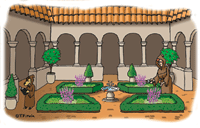 It
is a tribute to composting that humans have taken such a simple,
natural process and elevated it through myth and misunderstanding into a
form of new age alchemy. The spread of these myths has been
facilitated by word of mouth, misguided publications from solid waste
managers, and, worst of all, hard-core marketing. In order to keep
composting simple and inexpensive, let's put to rest some of the more
popular myths.
It
is a tribute to composting that humans have taken such a simple,
natural process and elevated it through myth and misunderstanding into a
form of new age alchemy. The spread of these myths has been
facilitated by word of mouth, misguided publications from solid waste
managers, and, worst of all, hard-core marketing. In order to keep
composting simple and inexpensive, let's put to rest some of the more
popular myths.Compost Bins
There are scores of weird and wonderful commercial designs available: from black plastic Klingon boxes to rotating drums to free-wheeling spheres. The prices range from tens to hundreds of dollars. Advertisements and popular literature lead many composting novices to believe that an enclosed bin is essential. The reality is that heaps or piles work just fine. If you want to keep your pile tidy, consider using wire mesh, or reusing scrap lumber, shipping pallets, cinder blocks, or an old trash can. If you want a prefabricated bin, consider volume before you buy: more money is often less capacity, with the highest capacity models generally selling for less than 40 dollars.
Bioactivators
These bacteria-laden powders and liquids are the snake oil of composting. While they do contain "cultured" strains of bacteria and other additives, the fact is that special inoculants are unnecessary. Recent studies suggest that there are approximately 10 trillion bacteria in a spoonful of garden soil. Every fallen leaf and blade of grass you add to your pile is already covered with hundreds of thousands of bacteria -- more than enough to do the job.
Yeast, Elixirs, and Worms
There are a number of recommended additives for boosting compost performance, most of which are unsubstantiated or silly. Adding yeast is the most common, which is expensive and useless. Some practitioners suggest pouring Coca Cola into the pile to increase biological activity, which will take place, though mostly in the form of yellow jackets and ants. Adding worms or worm cocoons has grown in popularity due to some confusion with vermicomposting. Worms do a tremendous amount of good, but need not be purchased or transplanted: just build a pile and they will come.
Fertilizer
Adding fertilizer to increase the nitrogen content of a pile is wasteful and expensive. More importantly, synthetically derived fertilizers contain high salt levels and other compounds (perhaps even pesticides) which are harmful to worms and microorganisms. If you must have additional nitrogen, use organic sources: spent grounds from a coffee shop, a neighbor's grass clippings, agricultural manures, or dried blood.
Lime
Many gardeners with a high proportion of acid-rich materials mistakenly add lime to their pile to produce compost with a balanced pH. Unfortunately, adding ground limestone will turn your compost ecosystem into an ammonia factory, with nitrogen rapidly lost as a noxious gas. Finished compost is almost always lightly alkaline naturally.
Odors
A properly built and managed compost pile should smell like the humus-sweet duff of a forest floor. Odors result primarily through mistakes: trying to compost grass clippings by themselves, adding too many food scraps (or the wrong types of food), and anaerobic conditions caused by poor drainage or lack of aeration.
Rodents and Pests
Compost piles almost never attract pests if they contain only yard trimmings. Adding food to a pile increases the attractiveness somewhat, but only if managed improperly, such as dumping scraps on the top of a pile or bin. Urban composters might want to avoid adding food altogether or use a worm box or a completely enclosed design. Meanwhile, compost piles fall well behind birdfeeders, outdoor pet food bowls, pet feces, and trash containers as residential causes for rodent activity.
 Layers
LayersAdding different types of material to a compost pile in varying proportions is appropriate only if all of the materials are on hand at one time, which is seldom the case. Moreover, lasagna-style compost piles must still be mixed and turned to evenly distribute materials: discreet layers of grass will simply clump together and become anaerobic. Mix, stir, and fluff to cook up your delicious batch of hard-working compost stew.
Fourteen-day Compost
A number of magazine ads have hoodwinked well-intentioned gardeners into thinking that they must produce compost in 14 days. Such expectations are unrealistic and unworthy. Decomposition takes time. While producing compost quickly has some merit, no one should feel compelled to purchase chipper-shredders or other elaborate equipment. In fact, even if material looks like compost after several weeks, it still requires a one-month maturation period before it should be used in the garden.
Compost Calculus
For years, books, periodicals, and composting brochures have obsessed on carbon-to-nitrogen ratios. Regrettably, the arcane charts, tables, and formulas provided overwhelm many gardeners. In truth, compost piles thrive when different types of material (moist and dry, green and brown) are mixed together. And while ratios are fine for compost hobbyists, regular gardeners need only remember that all organic materials will compost in a timely manner given some prudent attention.
Copyright 2014, Joseph M. Keyser













